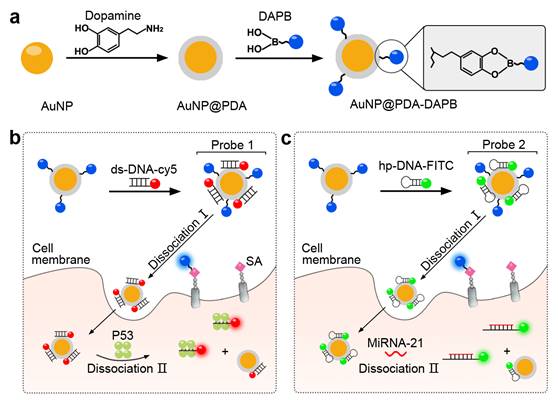The monitoring of cancer biomarkers has become a hot research issue in recent years, which is crucial to the early detection and treatment of cancer. Prof. Yi-Tao Long group has achieved remarkable progress in the field of the multilayer imaging of different cancer biomarkers in single cells. The work entitled “A Two-Stage Dissociation System for Multilayer Imaging of Cancer Biomarker-Synergic Networks in Single Cells” has been published in Angew. Chem. Int. Ed. (DOI: 10.1002/anie.201702415) recently.
Cancer biomarkers can be quantitatively measured to obtain information correlated to the presence of cancer, thus holding great promise for the early detection and diagnosis of cancer. These cancer biomarkers, including proteins, nucleic acids, and glycans, may locate on the surface of cell membrane or in the cytoplasm. Therefore, it is necessary to establish multifunctional systems for the multilayer detection of a variety of different cancer biomarkers located from the plasma membrane to the cytoplasm.This work reports a two-stage dissociation nanoparticle system based on multifunctionalized polydopamine-coated gold nanoparticles, which allows for the two-stage imaging of cancer biomarkers in single cells. During the interacting processes between the obtained probes and the targeted biomarkers located from the cell surface to the cytoplasm, the fluorescence tags leave from the probe surface and bind with the target biomarkers. Thus,this work realizes the in situ multilayer imaging of various cancer biomarkers in single living cells, presents a new concept of “layer-by-layer disassembly” and provides a potential tool for the exploration of the complex biomarker-synergic networks in cancer cells.

The first author of this work is Dr. Ruo-Can Qian, and the corresponding author is Prof. Yi-Tao Long. During the last two years, Prof. Long’s group has achieved a series of research results on the single-cell imaging, including Angew. Chem. Int. Ed. 2016, 55, 719-723, Anal. Chem. 2016, 88, 8640-8647 and Chem. Commun. 2016, 52, 13909-13911. These research works were supported by theScience Fund for Creative Research Groups (21421004), the 973 Program (Grants 2013CB733700), the Programme of Introducing Talents of Discipline to Universities and our university (East China University of Science and Technology).




